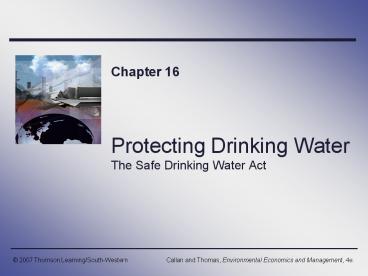Protecting Drinking Water The Safe Drinking Water Act - PowerPoint PPT Presentation
1 / 15
Title:
Protecting Drinking Water The Safe Drinking Water Act
Description:
Bottled Water. Not directly regulated under SDWA. Controlled by the FDA, not EPA. FDA must adopt EPA's standards for drinking water ... – PowerPoint PPT presentation
Number of Views:1133
Avg rating:3.0/5.0
Title: Protecting Drinking Water The Safe Drinking Water Act
1
Protecting Drinking WaterThe Safe Drinking Water
Act
- Chapter 16
2
Overview of Policy
- Safe Drinking Water Act (SDWA) of 1974
- Authorized EPA to set standards (shifted
responsibility from the Public Health Service) - All contaminants were addressed, not just
bacteria - SDWA Amendments of 1986
- Accelerated standard-setting imposed lead ban
improved protection of groundwater - SDWA Amendments of 1996
- Adds risk assessment and benefit-cost analysis to
standard-setting establishes a Drinking Water
State Revolving Fund (DWSRF) promotes prevention
3
Pollutants Controlled Under SDWA
- 83 contaminants listed in 1986 SDWA
- New contaminants are added from a list of
priority contaminants - Changes in 1996 Amendments
- Benefit-cost analysis and risk assessment govern
which contaminants to control and standard
setting - Establishes National Contaminant Occurrence
Database (NCOD) to identify contaminants
4
National Primary Drinking Water Regulations
(NPDWR)
- Aimed at protecting human health
- Uniformly applied to all public water systems
- Each NPDWR has three parts
- Maximum contaminant level goal (MCLG)
- level at which no known or expected adverse
health effects occur with margin of safety not
enforceable - Maximum contaminant level (MCL)
- highest level permitted as close to MCLG as
feasible enforceable - Best available technology (BAT)
- treatment technology that makes MCL achievable
5
National Secondary Drinking Water Regulations
- Guidelines to protect public welfare
- Called secondary maximum contaminant levels
(SMCLs) - Not enforceable by the federal government
- Not uniform
6
Bottled Water
- Not directly regulated under SDWA
- Controlled by the FDA, not EPA
- FDA must adopt EPAs standards for drinking water
- FDA has own standards for aesthetics and health
7
Economic Analysis
8
Standard-SettingFederal Role
- MCLGs are benefit-based
- Before 1996 SDWA, MCLs also were benefit-based,
since MCLs link to MCLGs - 1996 SWDA amendments requires EPA to conduct an
Economic Analysis (EA) for any proposed NPDWR - Must determine whether benefits of a new MCL
justify costs - Important because ignoring costs means MCLs could
be set to maximize benefits, causing
overregulation
9
Benefit-based MCL (at AB)
TSC
Maximum TSB
TSB
0
A
AB
Ae
10
Economic Analysis (EA) for the New Arsenic
Standard (Annualized values in 2003)
- Incremental Benefits
- Estimated value of avoided illness and premature
death - 154.2218.4 million per year
- Incremental Costs
- Treatment, monitoring, administrative expense
- 227.1 million per year
- Net Benefits
- 72.9 million to 8.7 million per year
- Since numerous potential benefits were not
monetized in the EA, EPA argued that the true
incremental benefits would justify the
incremental costs, and announced the new standard
in 2001
Source U.S. EPA, Office of Water, Office of
Ground Water and Drinking Water (December 2000).
11
Pricing Water
12
Does Price Matter?
- Some evidence to suggest that consumption of
water (Qd) is sensitive to price (P) - Comparing domestic with international data
- US water consumption is relatively high
- US water prices are relatively low
- Suggests that pricing water can influence
conservation
13
Local Pricing PracticesSurvey Data
- Flat fee pricing (29.3)
- price independent of use marginal P 0
- efficient only if MC 0
- Flat rate pricing (50.6)
- price increases with higher use at constant rate
- efficient only if MC were constant at same rate
- Variable rate pricing (30.6)
- declining block and increasing block
Source U.S. EPA, Office of Water (December
2002), p. 29.
14
Declining Block
- Price falls as Q rises
- Intent is to encourage consumption so that scale
economies can be achieved - Inefficient because it uses average cost pricing
vs. marginal cost pricing
15
Increasing Block
- Price rises as Q rises
- Provides incentive for conservation
- Efficient since it considers rising MC along with
MB of consumption































